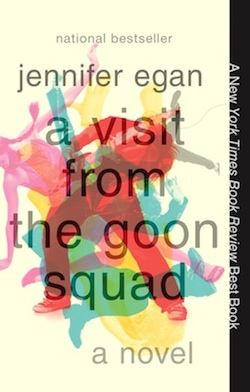Happy Book Expo of America Week! It’s Tuesday, which means it’s time for our weekly literary crossover series, Genre in the Mainstream. Every week we take one book or author from the mainstream of literary fiction and take a look at ways they cross over into the genres of science fiction, fantasy, or horror. We’re not saying these writers are necessarily part of these genres, but chances are if you like those kinds of books, you’ll like these, too!
This week, it’s the recent Pulitzer Prize winner, Jennifer Egan’s A Visit From the Goon Squad.
Right now, setting aside any of its genre musings, this novel is well written, totally original, and emotionally engaging. In short, it is deserving of all the hype and awards it and its author have received. I believe in Jennifer Egan, and I think you should, too.
However, the structure of the novel is also the sort of thing that when described might sound a little too complicated or “high concept” for its own good. Every chapter in A Visit From the Goon Squad takes place from the perspective of a different character, sometimes in different tenses, and almost completely out of chronological order. Telling a story from the perspective of numerous characters and without a regard for a linear narrative isn’t a brand new concept, but the way Egan employs it is particularly effective.
For example, in one chapter we meet two teenage girls hanging out with an older music executive at a punk show in New York City. In the very next chapter we have flashed forward and the girls are now in their 40s and standing by the bedside of the same man, who is now basically on his deathbed. Similarly, a seemingly minor character at the start of the novel becomes the focus at the end of the novel. He was in his 20s at the start, and then later in his 40s with a family and a new (futuristic!) job. Using this time-jump, Egan gives us the literary experience of how memory really functions. In our mind’s eye, the picture of our life story often looks like a jumble with the past and the future sort of blending together to form this bizarre tapestry that is our own biography.
This is not to say the Egan’s novel is “dream like” or “surreal.” This book is not like the magical realism of Borges or Steven Millhauser. The jumps through time, or into the perspective of different characters, are not designed to disorient the reader or keep them guessing. Nor is this device used to allow the author to get away with making things happen that don’t seem realistic. It is true that when you begin a new chapter, there is a momentary disorientation, where one might be looking for a familiar anchor. But it almost never takes all that long get grounded again because the themes and the characters are so specific that they become universal. It’s sort of like “I am The Walrus.” The character of Bennie is Sasha as Sasha is Lulu as Lulu is Ted and we are all together. It sounds silly, but the book really does feel that way. Even though you’ll be reading a chapter about a character you’ve never met, you feel as though you’ve been reading a book about this character the whole time.
But what about the science fiction? Well, despite jumping around in time, the book does eventually progress into a near future in which technologies and sensibilities have shifted in a significant manner. Because many of the characters are involved in one way or another with the music industry, the future of how music will be sold and promoted is explored in unique and original ways. In this future, there is a slang industry term known as “pointers” which refers to the fact that music can be downloaded by “pointing,” meaning anyone capable of “pointing” is now a customer. These customers include babies. There’s also a fantastic scene in which one of the characters endures a lecture on ethics from a younger character. The ethical structures of the future are full of jargon that sounds like a natural extension of our blog and text message generation.
Much of the prose towards these ending chapters is entirely in text messages. In this way, Egan employs a similar device that Gary Shteyngart did in Super Sad True Love Story. By giving us a near future depiction of how electronic communication would operate, she illustrates how we often think in text messages, e-mails and instant messages. In fact one of the last passages of the book occurs as a future-version of a text message.
This is not to say Egan (or Shteyngart for that matter) is writing a cautionary tale about the dangers of technology. Sure, there are some higher moral questions raised about the nature of promotion in this future world, but ultimately, as a writer, it seems like Egan is critiquing technology by embracing it. She shows us how technology is already part of our humanity, and how it will impact it in the future. To this point, one of the chapters takes place entirely as a Power Point presentation, indicating at some near point in the future, something like Power Point might be appropriated for artistic uses. Wait. I suppose it already has.
A Visit from the Goon Squad is a fantastic read first, and a novel that dips into speculative fiction second. However, it is all the better for the dipping, and you’ll be all the better for reading it.
Ryan Britt is a staff writer for Tor.com. His commentary on science fiction and literature has also appeared with Clarkesworld Magazine. His other writing has appeared with Nerve.com, Opium Magazine, Soon Quarterly, and elsewhere.










